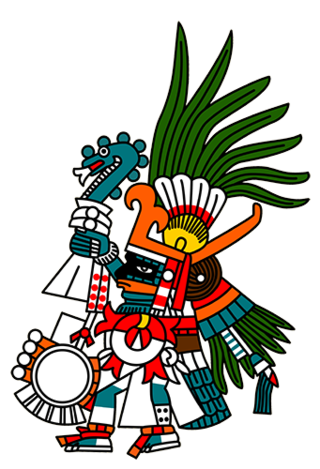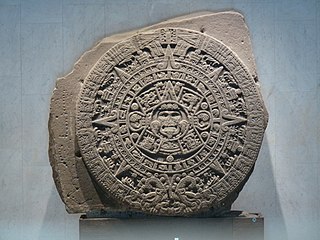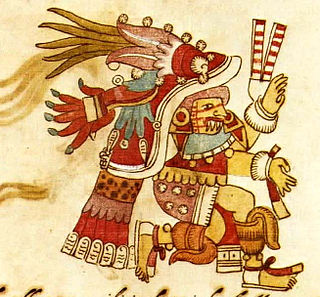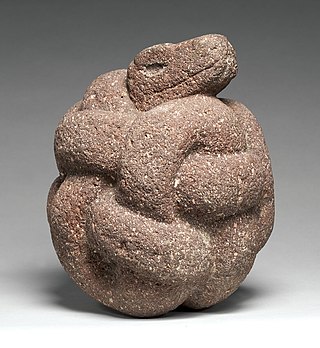
Tláloc is the god of rain in Aztec religion. He was also a deity of earthly fertility and water, worshipped as a giver of life and sustenance. This came to be due to many rituals, and sacrifices that were held in his name. He was feared, but not maliciously, for his power over hail, thunder, lightning, and even rain. He is also associated with caves, springs, and mountains, most specifically the sacred mountain where he was believed to reside. Cerro Tláloc is very important in understanding how rituals surrounding this deity played out. His followers were one of the oldest and most universal in ancient Mexico.

The Aztecs were a Mesoamerican culture that flourished in central Mexico in the post-classic period from 1300 to 1521. The Aztec people included different ethnic groups of central Mexico, particularly those groups who spoke the Nahuatl language and who dominated large parts of Mesoamerica from the 14th to the 16th centuries. Aztec culture was organized into city-states (altepetl), some of which joined to form alliances, political confederations, or empires. The Aztec Empire was a confederation of three city-states established in 1427: Tenochtitlan, city-state of the Mexica or Tenochca, Texcoco, and Tlacopan, previously part of the Tepanec empire, whose dominant power was Azcapotzalco. Although the term Aztecs is often narrowly restricted to the Mexica of Tenochtitlan, it is also broadly used to refer to Nahua polities or peoples of central Mexico in the prehispanic era, as well as the Spanish colonial era (1521–1821). The definitions of Aztec and Aztecs have long been the topic of scholarly discussion ever since German scientist Alexander von Humboldt established its common usage in the early 19th century.

In Aztec religion, Coyolxāuhqui is a daughter of the priestess Cōātlīcue. She was the leader of her brothers, the Centzon Huitznahua. She led her brothers in an attack against their mother, Cōātlīcue, when they learned she was pregnant, convinced she dishonored them all. The attack is thwarted by Coyolxāuhqui's other brother, Huitzilopochtli, the national deity of the Mexicas.

Huitzilopochtli is the solar and war deity of sacrifice in Aztec religion. He was also the patron god of the Aztecs and their capital city, Tenochtitlan. He wielded Xiuhcoatl, the fire serpent, as a weapon, thus also associating Huitzilopochtli with fire.

In Aztec mythology, Xiuhtecuhtli, was the god of fire, day and heat. In historical sources he is called by many names, which reflect his varied aspects and dwellings in the three parts of the cosmos. He was the lord of volcanoes, the personification of life after death, warmth in cold (fire), light in darkness and food during famine. He was also named Cuezaltzin ("flame") and Ixcozauhqui, and is sometimes considered to be the same as Huehueteotl, although Xiuhtecuhtli is usually shown as a young deity. His wife was Chalchiuhtlicue. Xiuhtecuhtli is sometimes considered to be a manifestation of Ometecuhtli, the Lord of Duality, and according to the Florentine Codex Xiuhtecuhtli was considered to be the father of the Gods, who dwelled in the turquoise enclosure in the center of earth. Xiuhtecuhtli-Huehueteotl was one of the oldest and most revered of the indigenous pantheon. The cult of the God of Fire, of the Year, and of Turquoise perhaps began as far back as the middle Preclassic period. Turquoise was the symbolic equivalent of fire for Aztec priests. A small fire was permanently kept alive at the sacred center of every Aztec home in honor of Xiuhtecuhtli.

The Templo Mayor was the main temple of the Mexica people in their capital city of Tenochtitlan, which is now Mexico City. Its architectural style belongs to the late Postclassic period of Mesoamerica. The temple was called Huēyi Teōcalli in the Nahuatl language. It was dedicated simultaneously to Huitzilopochtli, god of war, and Tlaloc, god of rain and agriculture, each of which had a shrine at the top of the pyramid with separate staircases. The central spire was devoted to Quetzalcoatl in his form as the wind god, Ehecatl. The Great Temple devoted to Huitzilopochtli and Tlaloc, measuring approximately 100 by 80 m at its base, dominated the Sacred Precinct. Construction of the first temple began sometime after 1325, and it was rebuilt six times. The temple was destroyed by the Spanish in 1521, and the Mexico City cathedral was built in its place.

Pre-Columbian art refers to the visual arts of indigenous peoples of the Caribbean, North, Central, and South Americas from at least 13,000 BCE to the European conquests starting in the late 15th and early 16th centuries. The Pre-Columbian era continued for a time after these in many places, or had a transitional phase afterwards. Many types of perishable artifacts that were once very common, such as woven textiles, typically have not been preserved, but Precolumbian monumental sculpture, metalwork in gold, pottery, and painting on ceramics, walls, and rocks have survived more frequently.

The Aztec sun stone is a late post-classic Mexica sculpture housed in the National Anthropology Museum in Mexico City, and is perhaps the most famous work of Mexica sculpture. It measures 3.6 metres (12 ft) in diameter and 98 centimetres (39 in) thick, and weighs 24,590 kg (54,210 lb). Shortly after the Spanish conquest, the monolithic sculpture was buried in the Zócalo, the main square of Mexico City. It was rediscovered on 17 December 1790 during repairs on the Mexico City Cathedral. Following its rediscovery, the sun stone was mounted on an exterior wall of the cathedral, where it remained until 1885. Early scholars initially thought that the stone was carved in the 1470s, though modern research suggests that it was carved some time between 1502 and 1521.

The Calmecac was a school for the sons of Aztec nobility in the Late Postclassic period of Mesoamerican history, where they would receive rigorous training in history, calendars, astronomy, religion, economy, law, ethics and warfare. The two main primary sources for information on the calmecac and telpochcalli are in Bernardino de Sahagún's Florentine Codex of the General History of the Things of New Spain and part 3 of the Codex Mendoza.

The Aztec religion is a polytheistic and monistic pantheism in which the Nahua concept of teotl was construed as the supreme god Ometeotl, as well as a diverse pantheon of lesser gods and manifestations of nature. The popular religion tended to embrace the mythological and polytheistic aspects, and the Aztec Empire's state religion sponsored both the monism of the upper classes and the popular heterodoxies.

Human sacrifice was common in many parts of Mesoamerica, so the rite was nothing new to the Aztecs when they arrived at the Valley of Mexico, nor was it something unique to pre-Columbian Mexico. Other Mesoamerican cultures, such as the Purépechas and Toltecs, and the Maya performed sacrifices as well and from archaeological evidence, it probably existed since the time of the Olmecs, and perhaps even throughout the early farming cultures of the region. However, the extent of human sacrifice is unknown among several Mesoamerican civilizations. What distinguished Aztec practice from Maya human sacrifice was the way in which it was embedded in everyday life. These cultures also notably sacrificed elements of their own population to the gods.

The Spanish conquest of the Aztec Empire, also known as the Conquest of Mexico, the Spanish-Aztec War (1519–1521), or the Conquest of Tenochtitlan was one of the primary events in the Spanish colonization of the Americas. There are multiple 16th-century narratives of the events by Spanish conquistadors, their indigenous allies, and the defeated Aztecs. It was not solely a small contingent of Spaniards defeating the Aztec Empire but a coalition of Spanish invaders with tributaries to the Aztecs, and most especially the Aztecs' indigenous enemies and rivals. They combined forces to defeat the Mexica of Tenochtitlan over a two-year period. For the Spanish, Mexico was part of a project of Spanish colonization of the New World after 25 years of permanent Spanish settlement and further exploration in the Caribbean.

Aztec architecture is a late form of Mesoamerican architecture developed by the Aztec civilization. Much of what is known about this style of architecture comes from the structures that are still standing. These structures have survived for several centuries because of the strong materials used and the skill of the builders. Most civic architecture was concentrated in the center of Aztec cities. However, many cities had smaller supplemental ceremonial areas.

Toxcatl was the name of the fifth twenty-day month or "veintena" of the Aztec calendar which lasted approximately from the 5th to the 22nd May, and of the festival which was held every year in this month. The Festival of Toxcatl was dedicated to the god Tezcatlipoca and featured the sacrifice of a young man who had been impersonating the deity for a full year.
Henry Bigger Nicholson who published under the name H.B. Nicholson, was a scholar of the Aztecs. His major scholarly monograph is Topiltzin Quetzalcoatl: The Once and Future Lord of the Toltecs (2001).

In Aztec religion, Chantico is the deity reigning over the fires in the family hearth. She broke a fast by eating paprika with roasted fish, and was turned into a dog by Tonacatecuhtli as punishment. She was associated with the town of Xochimilco, stonecutters, as well as warriorship. Chantico was described in various Pre-Columbian and colonial codices.

The coat of arms of Mexico is a national symbol of Mexico and depicts a Mexican (golden) eagle perched on a prickly pear cactus devouring a rattlesnake. The design is rooted in the legend that the Aztec people would know where to build their city once they saw an eagle eating a snake on top of a lake. The image has been an important symbol of Mexican politics and culture for centuries. To the people of Tenochtitlan, this symbol had strong religious connotations, and to the Europeans, it came to symbolize the triumph of good over evil.

Quetzalcoatl is a deity in Aztec culture and literature. Among the Aztecs, he was related to wind, Venus, Sun, merchants, arts, crafts, knowledge, and learning. He was also the patron god of the Aztec priesthood. He was one of several important gods in the Aztec pantheon, along with the gods Tlaloc, Tezcatlipoca and Huitzilopochtli. The two other gods represented by the planet Venus are Tlaloc and Xolotl.

The Double-headed serpent is an Aztec sculpture. It is a snake with two heads composed of mostly turquoise pieces applied to a wooden base. It came from Aztec Mexico and might have been worn or displayed in religious ceremonies. The mosaic is made of pieces of turquoise, spiny oyster shell and conch shell. The sculpture is at the British Museum. Ancient Aztecs have also termed this creature as 'Mansee' which translates as 'The Voice of Heart'.

The use of serpents in Aztec art ranges greatly from being an inclusion in the iconography of important religious figures such as Quetzalcoatl and Cōātlīcue, to being used as symbols on Aztec ritual objects, and decorative stand-alone representations which adorned the walls of monuments such as the Templo Mayor.





























